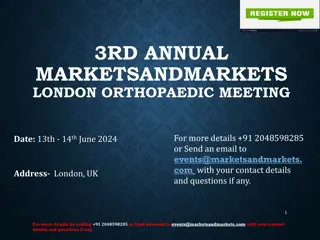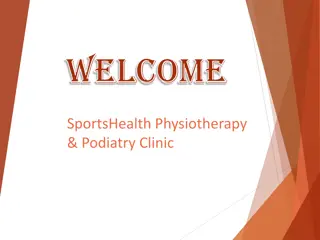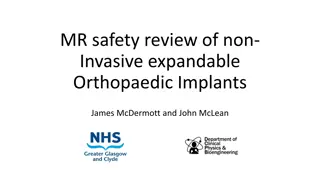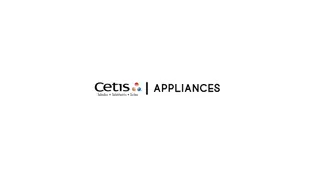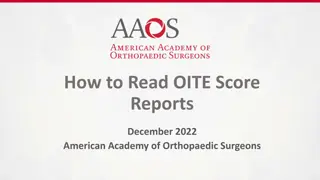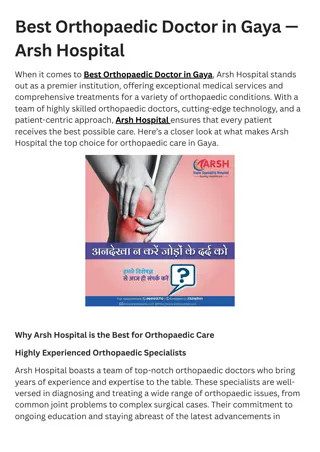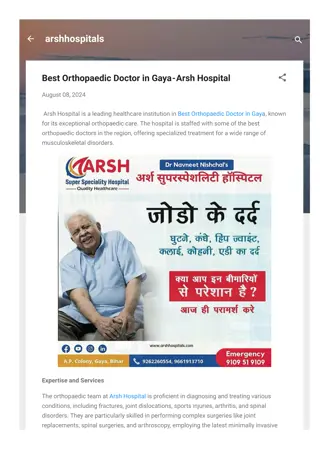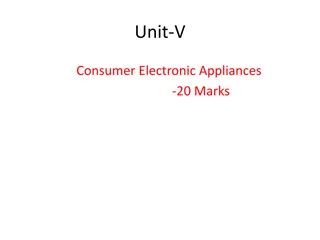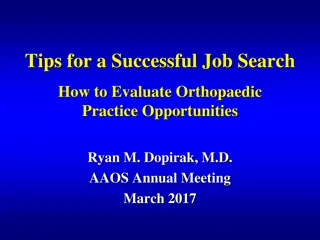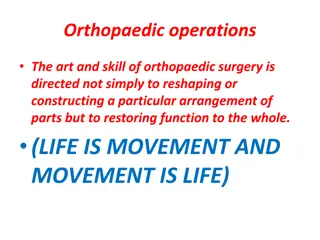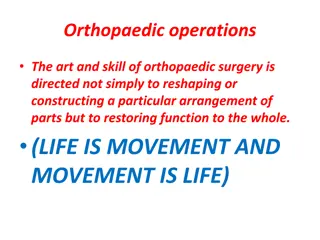
Orthopaedic Appliance in Orthodontics & Dentofacial Orthopedics
Learn about the use of orthopedic appliances in orthodontics and dentofacial orthopedics, including the functions and indications of face masks and headgears. Explore different sites of anchorage and biomechanical considerations for effective treatment.
Download Presentation

Please find below an Image/Link to download the presentation.
The content on the website is provided AS IS for your information and personal use only. It may not be sold, licensed, or shared on other websites without obtaining consent from the author. If you encounter any issues during the download, it is possible that the publisher has removed the file from their server.
You are allowed to download the files provided on this website for personal or commercial use, subject to the condition that they are used lawfully. All files are the property of their respective owners.
The content on the website is provided AS IS for your information and personal use only. It may not be sold, licensed, or shared on other websites without obtaining consent from the author.
E N D
Presentation Transcript
RUNGTA COLLEGE OF DENTAL SCIENCES & RESEARCH TITLE OF THE TOPIC- ORTHOPAEDIC APPLIANCE DEPARTMENT OF ORTHODONTICS AND DENTOFACIAL ORTHOPAEDICS
CORE AREAS DEFINITIONS BASICS HEADGEAR DOMAIN CATEGORY DESIRE TO KNOW AFFECTIVE COGNITIVE MUST KNOW COGNITIVE MUST KNOW COGNITIVE FACEMASK MUST KNOW COGNITIVE CHIN CUP MUST KNOW
Face Mask Headgears are generally used for the purpose of reinforcement of anchorage or for maxillary distalization . However when anterior protractory force is required a protraction headgear is used.Facial mask therapy has gain ed popularly in last decade .The principle of pulling force on the maxillary structures with reciprocal pushing force on the forehead or mandible through facial anchorage is simple and mechanically sound enough to be used as therapeutic procedure for treatment of prognathic syndromes,maxillary retrusions and mandibular prognathism.
Indications It can be used in growing patient having a prognathic mandible and a retrusive maxilla It can be used for bending the condylar neck for stimulating temporo mandibular joint adaptations to posterior dispalacement of the chin . It can be also used for correction of post surgical relapse after osteo mies . It can also be used for selective rearrangement of the palatal shelves in cleft patients .
Sites of anchorage 1.Anchorage from chin : In this type of protraction headgear which is co,,only used in Britain , chin cup with posts are employed .As the anchorage is obtained solely from the chin , the force is transmitted to the condylar cartilage and thereby has a disadvantage of altering the growth of mandible.
2.Anchorage from skull: Certain forms of reverse pull headgears obtain anchorage only from forehead . 3.Anchorage from Chin &forehead: This face mask makes use of anchorage from both the chin & forehead .
Biomechanical considerations 1.Amount of force : The amount of force required to bring about skeletal changes is abount 1 pound per side. 2.Direction of force: Most authors recommend a 15-20 degree downward pull to the occlusal plane to produce a pure forward translatory motion of the maxilla . 3.Duration of force: The time taken to achieve desired results is proportional to the amount of force utilized.
Frequency of use: Most authors recommend 12-14 hours of wear a day. Parts of reverse pull head gear The reverse pull headgear consists of the following parts Chin cup : Most protraction headgears obtain anchorage from the chin as well as the forehead . The chin cup is used to take anchorage from the chin area . Forehead cap : The forehead support or cap or strap is used to derive anchorage from the forehead.
Elastics : Elastic force is used to apply a forward traction on the upper arch. Intraoral appliances : The most common type of protraction device is a multi banded appliance with rigid wire. Metal Frame : The main component of a facemask assembly is the metal frame.It connects the various component such as chincup and forehead cap.
Types of reverse pull headgear 1.Protraction headgear by Hickham: Developed in the early 1960s this appliance uses the chin and top of the head for anchorage .The folrce distribution as follows 15 % head 85 % chin.It consists of 2 short arms in front of the mouth to engage maxillary protraction elastics. 2.Facemask olf Delaire : This was popularised by Delaire in 1960 and also uses the chin and forehead for support . 3.Tubinger model : This is a modified type ofv Delaire facemask . It consists of a chin cup from which originates two rods that run in the midline and is shaped to avoid the interference of the nose .
Tubinger facemask
4.Petit type of face mask : This is also a modified form of Delaire face mask . It consists of a chin cap and a forehead cap with a single rod running in the midline from forehead cap to chin cup.
Chin cup The chin cup or the chin cap as it is sometimes referred to is an extraoral orthopaedic device that covers the chin and is connected to a head gear. It is used to restrict the forward and downward growth of the mandible.
A.Occipitalpull B vertical pullchin cup
Types of chin cup Chin cup are of two types .They are the occipital pull chin cup and the vertical pull chin cup . 1.Occipital pull chin cup : This type of chin cup derives from the occipital region commonly used in malocclussion associated with mild to moderate mandibular prognathism . 2.Vertical pull Chin cup : This type of chin cup derives anchorage from parietal region of the head
Fabrication of the chin cup Chin cups are either fabricated individually for the patient or pre fabricated commercially available chin cups can be used .The fabrication of chin cup requires an impressions to be taken of the chin area . Force magnitude and duration of wear At the time of appliance delivery a force of 150-300 gms per side is used .Over the next 2 months the force is gradually incresed to 450-700 gms per side .The patient is asked to wear the appliance for 12- 14 hrs a day to achieve the desired results.
Extraoral traction devices are those that utilize anchorage outside the oral cavity for efficient application of force in direction not otherwise possible. These appliances are capable of producing orthodontic and orthopedic effects. Anchorage obtained outside the oral cavity can be based on different areas as follows: Cervical: Utilizing neck for anchorage (e.g. neck straps) Occipital: Utilizing the occipital region for anchorage (e.g. headgears) Cranial: Involving the cranium as a source of anchorage (e.g. high-pull headgears) Facial: Involving aspects of the face as a source of anchorage (e.g. face masks)
Textbook of Orthodontics Gurkeerat Singh, Jaypee Brothers; 2nd Edition Orthodontics The Art and Science, S.I Bhalajhi, AryaMedi Publishing; 7th Edition Textbook of Orthodontics Sridhar Premkumar, Elsevier; 1st Edition Orthodontics: Diagnosis and Management of Malocclusion and Dentofacial Deformities O.P Kharbanda, Elsevier; 1st Edition

